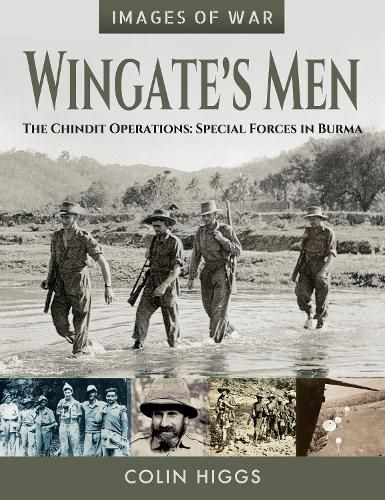Readings Newsletter
Become a Readings Member to make your shopping experience even easier.
Sign in or sign up for free!
You’re not far away from qualifying for FREE standard shipping within Australia
You’ve qualified for FREE standard shipping within Australia
The cart is loading…






Possibly the most famous fighting formations of the Burma campaign during the Second World War were the Long Range Penetration Groups, more commonly known as the Chindits. Colonel Orde Wingate was given permission to attempt long-range operations deep within Japanese-held territory with the aim of sowing alarm and confusion amongst the enemy and disrupting Japanese plans for the invasion of India. For this, Wingate was given the Indian 77th Infantry Brigade. In February 1943 this force crossed into Burma on its first Chindit operation, codenamed Loincloth. The Chindits took the Japanese by surprise, putting one of the main railway lines out of order, but the Japanese responded quickly, interdicting supply drops to the Chindits who soon began to suffer severely from exhaustion and shortages of water and food. With three brigades chasing them, the Chindits headed back to India, being forced to break up into small groups to avoid capture. By the time the 77th Brigade crossed the border, it had lost a third of its strength. Despite the heavy losses, Wingate had shown that British troops could operate successfully against the Japanese in inhospitable terrain. Promoted to acting major general Wingate was granted permission to undertake another Chindit operation, but this time on a far greater scale. In Operation Thursday Wingate aimed to fly a force of 10,000 men, 1,000 mules, equipment and supplies into clearings in the heart of Burma behind enemy lines. The operation proved a considerable success, the Chindits causing mayhem amongst the Japanese forces. Wingate, though, did not live to see the end of Operation Thursday, as he was killed when the aircraft in which he was being transported to one of the Chindit bases crashed into the jungle. In this wonderful collection of photographs, drawn in large part from one man s photograph albums, we see the harsh conditions in which the Chindits had to operate, and the terrible physical state of many of the men who survived the jungles, the dry plains, and the ferocious Japanese enemy. AUTHOR: Colin Higgs has more than twenty-five years experience in the broadcast and home entertainment industries and for much of that time has co-produced, written and researched aviation documentaries together with Bruce Vigar of Leading Edge TV. Colin s business, A Flying History, was created to make accessible the unique Peter Keating and John Stroud aviation photograph collections and Colin and Bruce’s extensive archive of first-hand interviews with RAF veterans.
150 b/w images
$9.00 standard shipping within Australia
FREE standard shipping within Australia for orders over $100.00
Express & International shipping calculated at checkout
Possibly the most famous fighting formations of the Burma campaign during the Second World War were the Long Range Penetration Groups, more commonly known as the Chindits. Colonel Orde Wingate was given permission to attempt long-range operations deep within Japanese-held territory with the aim of sowing alarm and confusion amongst the enemy and disrupting Japanese plans for the invasion of India. For this, Wingate was given the Indian 77th Infantry Brigade. In February 1943 this force crossed into Burma on its first Chindit operation, codenamed Loincloth. The Chindits took the Japanese by surprise, putting one of the main railway lines out of order, but the Japanese responded quickly, interdicting supply drops to the Chindits who soon began to suffer severely from exhaustion and shortages of water and food. With three brigades chasing them, the Chindits headed back to India, being forced to break up into small groups to avoid capture. By the time the 77th Brigade crossed the border, it had lost a third of its strength. Despite the heavy losses, Wingate had shown that British troops could operate successfully against the Japanese in inhospitable terrain. Promoted to acting major general Wingate was granted permission to undertake another Chindit operation, but this time on a far greater scale. In Operation Thursday Wingate aimed to fly a force of 10,000 men, 1,000 mules, equipment and supplies into clearings in the heart of Burma behind enemy lines. The operation proved a considerable success, the Chindits causing mayhem amongst the Japanese forces. Wingate, though, did not live to see the end of Operation Thursday, as he was killed when the aircraft in which he was being transported to one of the Chindit bases crashed into the jungle. In this wonderful collection of photographs, drawn in large part from one man s photograph albums, we see the harsh conditions in which the Chindits had to operate, and the terrible physical state of many of the men who survived the jungles, the dry plains, and the ferocious Japanese enemy. AUTHOR: Colin Higgs has more than twenty-five years experience in the broadcast and home entertainment industries and for much of that time has co-produced, written and researched aviation documentaries together with Bruce Vigar of Leading Edge TV. Colin s business, A Flying History, was created to make accessible the unique Peter Keating and John Stroud aviation photograph collections and Colin and Bruce’s extensive archive of first-hand interviews with RAF veterans.
150 b/w images